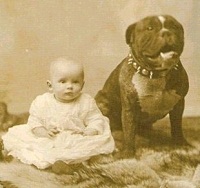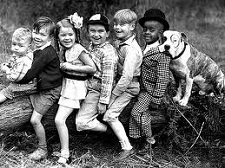A Breed Apart :: The "Pit Bull" Debunked
| The term "Pit Bull" refers not to a single breed but a group of breeds, including the American Pit Bull Terrier, American Staffordshire Terrier, the Staffordshire Bull Terrier, among others. Most originated from pairings of the ancestors we now call the Olde English Bulldogge and Terriers. Their breeders wanted to merge the muscular body and tenacity of the bulldog with the agility and "gameness" of terriers. |
 |
Originally bred for blood sports like bull- and bear-baiting in Europe and North America, these dogs were trained to attack and immobilize the agitated animal and so were favored for their large, strong jaws and muscular necks and shoulders. When these sports were outlawed in the early 1800s, people began fighting the dogs, a sport more easily concealed from the authorities. Since then, their bad reputation, much inflated by the media, has made them the target of unfair discrimination, breed specific legislation (breed banning) and, thanks to their "tough dog" image, a favorite dog in the more illegal enterprises.

| The truth is that this highly intelligent, energetic, affectionate breed loves people. Pit Bulls were prized as wonderful family dogs in years past. In fact, they once had the moniker of "nanny dog" because of their wonderful demeanor with children. |
Most experts agree that today's Pit Bull is a short-coated dog characterized by a wide skull, powerful jaws and a muscular, stocky body. But there is great variation in the Pit Bull's appearance. Typically 35 to 65 pounds, some weigh as little as 25 pounds, while others tip the scales at 80 pounds or more. While some have bulkier frames and colossal skulls, others have leaner, more muscular bodies. All are strong and athletic. With their impressive stamina and staunch work ethic, Pit Bulls enjoy a variety of sports such as agility, disc dog competitions, flyball, freestyle and competitive obedience. They often excel in weight-pulling contests and schutzhund.
Pit Bulls are typically very friendly, even with strangers. They love people and thrive on attention and affection. Because of their terrier bloodlines, Pit Bulls have a high prey drive, meaning they will frequently chase and grab small animals. Since most terriers were bred for eradicating small rodents, Pit Bulls have a tendency to not get along with other animals, including dogs. This makes their early socialization with other animals especially important.
Pit Bulls also have a tendency to be easily aroused or over-excited and, once riled, it can be difficult for them to calm down, so adequate exercise and training are a must with these dogs. They are not the best choice for the first-time dog owner due to their strength and high energy level and, for the more rambunctious dogs, homes with older children are advised due to their energy and strength.
Because of their unfortunate reputation, owning a Pit Bull can be a greater responsibility than owning another breed. It is important that they be well-trained and socialized so they can be good ambassadors for their group. Yet, those dog guardians ready for the challenge and effort of Pit Bull ownership will find it to be one of the most loyal, loving, and wonderful companions on four legs.

| Did you know that Helen Keller, the famous blind and deaf author, activist, and lecturer of the early 1900s, owned a Pit Bull? Or that Petey from the popular series of the 1920s and 1930s, The Little Rascals, was also a Pit Bull? And during World War I and World War II, Pit Bulls were frequently used to carry messages on the battlefield. |




